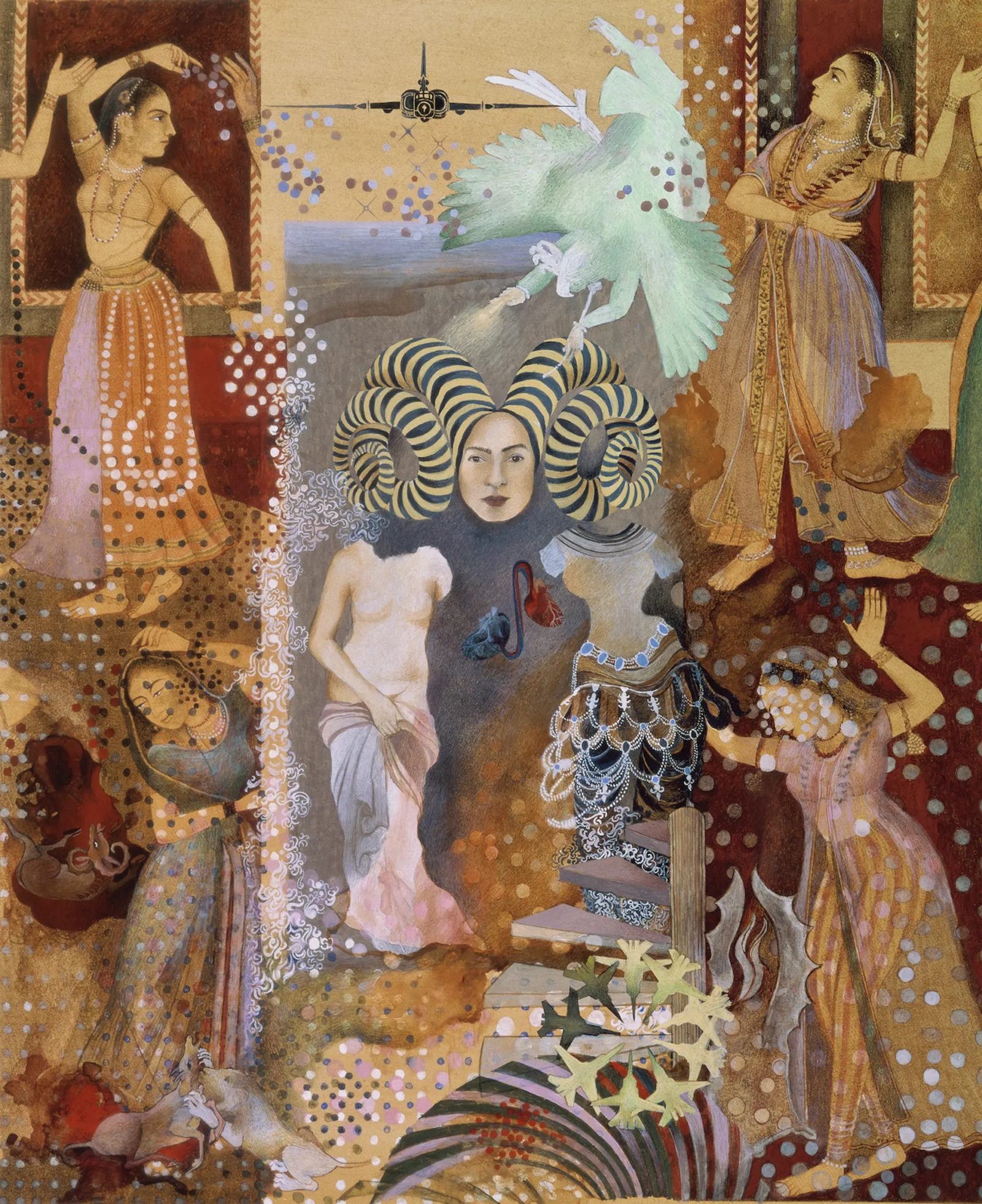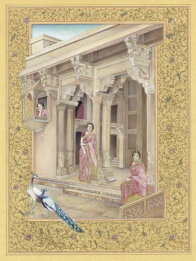Shahzia Sikander: Extraordinary Realities Opens March 20 at MFAH

The Museum of Fine Arts, Houston will be the final stop for Shahzia Sikander: Extraordinary Realities, some 60 paintings, drawings and video animations examining the prolific first 15 years of the artist’s career. Organized by the Rhode Island School of Design Museum, the exhibition will be on view at the MFAH from Sunday, March 20, 2022 through June 5, 2022.
Born in Lahore in 1969, Pakistani American artist Shahzia Sikander is internationally celebrated for bringing manuscript painting traditions from South and Central Asia into dialogue with contemporary art practice. This exhibition includes nearly 60 works borrowed from public and private collections and tracks the first 15 years of her artistic journey: her groundbreaking deconstruction of manuscript painting in Pakistan; development of a new personal approach during her first years in New York, when vocabulary in her graduate years at the Rhode Island School of Design; expanded explorations around identity as a Core Fellow at the Glassell School of Art at the Museum of Fine Arts, Houston; and her global Sikander richly interrogated gender, sexuality, race, class, and history, creating open-ended narratives that have sustained her as one of the most significant artists working today.
“We are delighted to bring this exhibition focusing on Shahzia Sikander’s early works which includes her time in Houston as a Core Fellow at the Glassell School of Art,” said Gary Tinterow, Director and Margaret Alkek Williams Chair, the Museum of Fine Arts, Houston. “Her vibrant synthesis of illustrated manuscript painting with contemporary art practice has played a critical role in recognizing a wider range of perspectives, including those of women, people of color, Muslims, and artists working outside the US and Europe. We are pleased to bring back Sikander’s richly vibrant and varied work to the MFAH.”
Exhibition Overview
 The exhibition begins with work Sikander made while studying miniature, or manuscript, painting at the National College of Arts (NCA) in Lahore (1987–91). Her decision to major in this tradition was met with skepticism at the school, where many viewed the practice as lacking in creativity. Manuscript painting had a tireless advocate at the NCA in Professor Bashir Ahmad, whose passion intimated the potential of this territory. Working under his mentorship, Sikander ruptured all expectations with her thesis, The Scroll (1989–1990), which was striking for the originality of its subject, format, scale, and execution. With this work, she demonstrated the tradition’s potential for experimentation and relevance to contemporary art, beginning what would become a neo miniature movement in Pakistan.
The exhibition begins with work Sikander made while studying miniature, or manuscript, painting at the National College of Arts (NCA) in Lahore (1987–91). Her decision to major in this tradition was met with skepticism at the school, where many viewed the practice as lacking in creativity. Manuscript painting had a tireless advocate at the NCA in Professor Bashir Ahmad, whose passion intimated the potential of this territory. Working under his mentorship, Sikander ruptured all expectations with her thesis, The Scroll (1989–1990), which was striking for the originality of its subject, format, scale, and execution. With this work, she demonstrated the tradition’s potential for experimentation and relevance to contemporary art, beginning what would become a neo miniature movement in Pakistan.
During her residency at the Glassell School of Art from 1995 to 1997 Sikander began creating narratives that referenced multiple time periods, geographies, and traditions. Her work became more expansive in its interpretation, and at the same time began to increase in scale as she combined and layered her tracing-paper drawings. Her focus on women continued with new imagery and themes inspired by the region’s culture as well as her engagement with Project Row Houses, in Houston, through which she gained a deeper understanding of American race relations as she explored racial and other underrepresented narratives and scaled up her work. Sikander created imagery that quickly brought her to the fore of the American art world with shows in a number of prestigious venues. The final section of the exhibition includes work following Sikander’s 1997 move to New York, where she still lives. She has continued to make work grounded in manuscript painting traditions while expanding her ambitious wall drawings and floor-to ceiling installations, layering works on tracing paper. The terrorist attacks of 9/11 and their aftermath opened up new engagement around economics, global trade, and news cycles, and Sikander’s work became more overtly political. The dynamism of her drawings led Sikander in the early 2000s to video animations, which today comprise a major part of her practice. The MFAH presentation of Extraordinary Realities will showcase the animation Parallax, a shared acquisition between the MFAH and the Whitney Museum of American Art, which exploits the manuscript painting’s capacity for transformation to maximum effect: by combining digital technologies that add movement and sound, and by magnifying the tiniest, indiscernible details, Sikander reflects on past and present to tell the story of colonialism and capitalism.
Shahzia Sikander: Extraordinary Realities
Millennium Gallery, Beck Building
March 20 – June 5, 2022
More information available at www.mfah.org/shahziasikander
Publication
Shahzia Sikander: Extraordinary Realities will be accompanied by a publication of the same title, edited by Sadia Abbas and Jan Howard, which includes contributions from Bashir Ahmad, Dennis Congdon, Faisal Devji, Gayatri Gopinath, Vasif Kortun, Rick Lowe, Julie Mehretu, Kishwar Rizvi, Shahzia Sikander, and John W. Smith. Comprising new archival material, fresh scholarly essays, and conversations with artists, curators, and Sikander’s teachers, the book presents a bold, in-depth examination of the artist’s early work.
Organization & Funding
Shahzia Sikander: Extraordinary Realities is organized by the RISD Museum and presented in collaboration with the Museum of Fine Arts, Houston. This exhibition originated at the RISD Museum thanks to generous federal, private, and endowment support.
Major support is provided by:
Leslie and Brad Bucher
Generous funding provided by:
Rhodes and Leona B. Carpenter Foundation
The Margaret Cooke Skidmore Exhibition Endowment
Bettie Cartwright
Jereann Chaney and Holland Chaney
Alice Kleberg Reynolds Foundation
About the Museum of Fine Arts, Houston
Spanning 14 acres in the heart of Houston’s Museum District, the main campus comprises the Audrey Jones Beck Building, the Caroline Wiess Law Building, the Lillie and Hugh Roy Cullen Sculpture Garden and the Nancy and Rich Kinder Building. Nearby, two house museums—Bayou Bend Collection and Gardens, and Rienzi—present collections of American and European decorative arts. The MFAH is also home to the Glassell School of Art, with its Core Residency Program and Junior and Studio schools; and the International Center for the Arts of the Americas (ICAA), a leading research institute for 20th-century Latin American and Latino art. www.mfah.org























